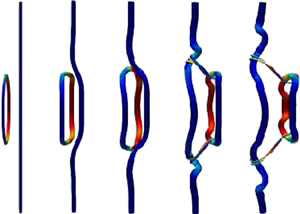Published online by Cambridge University Press: 06 August 2020

Reconnection plays a significant role in the dynamics of plasmas, polymers and macromolecules, as well as in numerous laminar and turbulent flow phenomena in both classical and quantum fluids. Extensive studies in quantum vortex reconnection show that the minimum separation distance  $\delta$ between interacting vortices follows a
$\delta$ between interacting vortices follows a  $\delta(t) \sim t^{1/2}$ scaling. Due to the complex nature of the dynamics (e.g. the formation of bridges and threads as well as successive reconnections and avalanche), such scaling has never been reported for (classical) viscous vortex reconnection. Using direct numerical simulation of the Navier–Stokes equations, we study viscous reconnection of slender vortices, whose core size is much smaller than the radius of the vortex curvature. For separations that are large compared to the vortex core size, we discover that
$\delta(t) \sim t^{1/2}$ scaling. Due to the complex nature of the dynamics (e.g. the formation of bridges and threads as well as successive reconnections and avalanche), such scaling has never been reported for (classical) viscous vortex reconnection. Using direct numerical simulation of the Navier–Stokes equations, we study viscous reconnection of slender vortices, whose core size is much smaller than the radius of the vortex curvature. For separations that are large compared to the vortex core size, we discover that  $\delta (t)$ between the two interacting viscous vortices surprisingly also follows the 1/2-power scaling for both pre- and post-reconnection events. The prefactors in this 1/2-power law are found to depend not only on the initial configuration but also on the vortex Reynolds number (or viscosity). Our finding in viscous reconnection, complementing numerous works on quantum vortex reconnection, suggests that there is indeed a universal route for reconnection – an essential result for understanding the various facets of the vortex reconnection phenomena and their potential modelling, as well as possibly explaining turbulence cascade physics.
$\delta (t)$ between the two interacting viscous vortices surprisingly also follows the 1/2-power scaling for both pre- and post-reconnection events. The prefactors in this 1/2-power law are found to depend not only on the initial configuration but also on the vortex Reynolds number (or viscosity). Our finding in viscous reconnection, complementing numerous works on quantum vortex reconnection, suggests that there is indeed a universal route for reconnection – an essential result for understanding the various facets of the vortex reconnection phenomena and their potential modelling, as well as possibly explaining turbulence cascade physics.
Evolution of flow structures for reconnection of colliding vortex rings at Re Γ = 2000 using direct numerical simulation of Naiver-Stokes equation. The radius of the vortex ring is R=1 and the initial minimum distance between two rings is δ0 = 0.2. The flow structures are represented by vorticity isosurface at 5% of maximum initial vorticity |ω| = 0.05ω0.
Evolution of vortex axis for reconnection of colliding vortex rings at ReΓ = 2000
Evolution of vortex axis for reconnection of colliding vortex rings at ReΓ = 2000
Evolution of vortex axis for reconnection of orthogonal straight vortex tubes at ReΓ= 2000.
Evolution of flow structures for reconnection of vortex ring with a straight tube at ReΓ= 2000 using direct numerical simulation of Naiver-Stokes equation. The radius of the vortex ring is R = 1 and the initial minimum distance is δ0 = 0.4. The flow structures are represented by vorticity isosurface at 5% of maximum initial vorticity |ω| = 0.05ω0 .